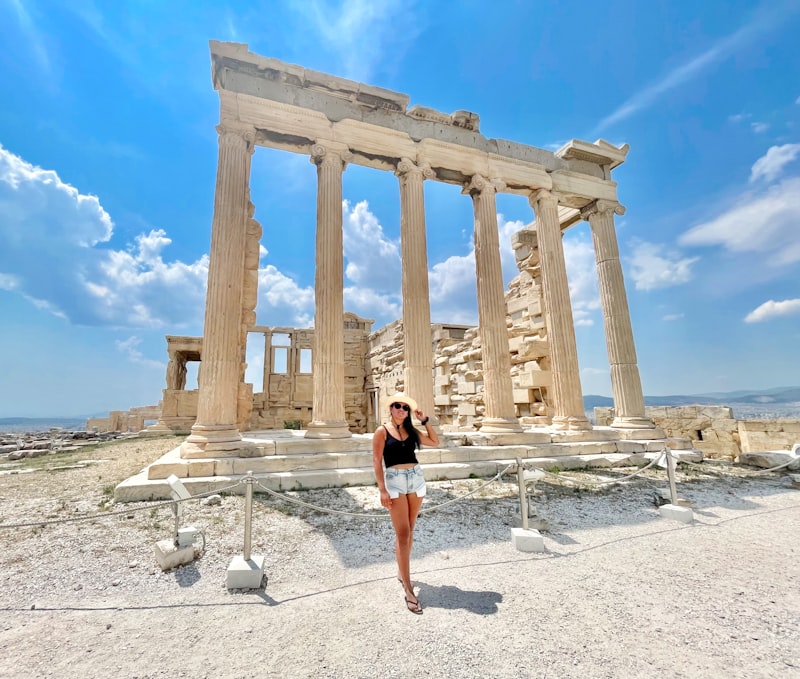Imagine standing at the foot of the Acropolis, where the Parthenon reigns supreme, a testament to the ingenuity of ancient Greek architecture. Its marble columns, once adorned with vibrant statues and friezes, tell tales of Athena, goddess of wisdom and war. The Parthenon isn’t just a temple; it’s a symbol of Athenian democracy and the birthplace of Western art and philosophy.
Stroll further, and you’ll encounter the Temple of Olympian Zeus, once the largest temple in Greece. Its colossal columns, though weathered by time and history’s hand, still command reverence and awe. Nearby, Hadrian’s Arch stands proudly, marking the boundary between the ancient city and the Roman quarters, a gateway to a different era.
The Agora, Athens’ ancient marketplace, invites you to wander its pathways where Socrates once debated and Aristotle pondered. It’s not just ruins; it’s where democracy found its voice, and where the foundations of Western political thought were laid.
Venture to the Kerameikos, Athens’ ancient cemetery, where marble gravestones mark the resting places of soldiers, statesmen, and poets alike. Here, history isn’t just etched in stone; it’s a narrative of lives lived and lost, echoing through the ages.

As you stand atop Mars Hill, or Areopagus, you’re reminded of the Apostle Paul’s sermon to the Athenians, a testament to how Athens influenced early Christianity. The hill offers not just a panoramic view of the city, but a glimpse into its spiritual and philosophical heritage.
Athens, with its blend of ancient wonders and modern vitality, invites visitors to uncover layers of history buried beneath its bustling streets. Each step reveals a new chapter, where the past and present converge in a dance of timelessness.
Unveiling Athens: Exploring the Ancient Marvels Beyond the Acropolis
Athens, the cradle of Western civilization, beckons with more than just its iconic Acropolis. Beyond the towering Parthenon lies a tapestry of ancient marvels waiting to be explored. Imagine strolling through history’s corridors, where each step whispers tales of gods, philosophers, and empires.
Venturing beyond the Acropolis unveils a cityscape steeped in millennia-old stories. Take a leisurely walk to the Agora, the heart of ancient Athens. Here, amidst the ruins of temples and civic buildings, you can almost feel the pulse of Athenian democracy that shaped the Western political thought.
A short distance away lies the Temple of Olympian Zeus, a testament to ancient engineering prowess. Imagine standing before its colossal columns, once part of the largest temple in Greece, dedicated to the king of gods himself. It’s a humbling experience, reminding us of the grandeur and ambition of ancient civilizations.
For a change of pace, delve into the mystical depths of the Erechtheion, where the renowned Porch of the Caryatids stands gracefully. These iconic maidens, sculpted in place of columns, guard the sacred relics of Athena and Poseidon. It’s a blend of myth and architectural finesse that leaves visitors awe-inspired.
Beyond monuments, Athens offers a cultural tapestry woven with vibrant neighborhoods like Plaka. Lose yourself in its labyrinthine streets lined with neoclassical buildings, cozy tavernas, and artisan shops. It’s a living canvas where the old and new harmoniously coexist, inviting exploration at every turn.
In essence, uncovering Athens beyond the Acropolis is akin to peeling back layers of history, revealing a city that embraces its past while embracing the future. Whether you’re a history enthusiast or a casual traveler, each corner offers a glimpse into the enduring legacy of ancient Greece.
This article aims to captivate readers by painting a vivid picture of Athens’ historical richness beyond its famous landmark, using engaging language and vivid descriptions.
Hidden Gems: Discovering Lesser-Known Treasures of Athens’ Rich History
Imagine wandering through the charming Plaka district, where narrow cobblestone streets wind past neoclassical mansions adorned with bougainvillea. Here, tucked away from the bustling crowds, lie quaint Byzantine churches like the Church of Kapnikarea, a small yet significant piece of Athens’ religious history dating back to the 11th century.
Venturing further, explore the tranquil Anafiotika neighborhood nestled beneath the Acropolis. Built by settlers from the island of Anafi in the 19th century, its whitewashed houses and labyrinthine alleys evoke the serene simplicity of the Greek islands amidst the urban sprawl.
For those with a penchant for art and culture, the Benaki Museum offers a fascinating journey through Greek history, spanning from antiquity to modern times. Housed in a beautiful neoclassical mansion, its collections include everything from exquisite Byzantine icons to artifacts from the Greek War of Independence, providing insights into the nation’s tumultuous yet resilient past.
Athens also boasts the National Gardens, a verdant oasis in the heart of the city. Originally King Otto’s royal garden, it now serves as a peaceful retreat where visitors can stroll among towering palms, fragrant orange trees, and tranquil ponds. Adjacent to it, the Zappeion Hall stands as a testament to Greece’s revival as a modern state, hosting events that have shaped its contemporary political landscape.
Timeless Splendor: Iconic Temples and Theaters of Ancient Athens
Imagine walking through the marble columns of the Parthenon, perched majestically atop the Acropolis hill. Built in the 5th century BC as a tribute to the goddess Athena, this monumental temple is an architectural marvel, embodying the peak of Classical Greek art and engineering. Its intricate sculptures and Doric columns evoke a sense of awe, while offering panoramic views of the sprawling city below.
Nearby, the Theatre of Dionysus whispers tales of ancient drama and theatrical genius. Carved into the southern slope of the Acropolis, this amphitheater is where the works of Aeschylus, Sophocles, Euripides, and Aristophanes came to life before enraptured audiences. Imagine the echoes of poetic verses and tragic narratives that once reverberated through its stone tiers, shaping the very essence of Western theater.
Journeying further through Athens, one encounters the Temple of Olympian Zeus, a colossal structure dedicated to the king of the gods. Conceived on an ambitious scale, its construction spanned centuries, a testament to the enduring dedication of Athenian craftsmanship. Though largely in ruins today, its surviving columns stand tall against the backdrop of modern Athens, a reminder of the city’s former grandeur.
Not far from the temple, the Odeon of Herodes Atticus stands as a testament to the enduring legacy of ancient Athens’ cultural vibrancy. Built in 161 AD, this open-air theater has hosted performances ranging from ancient tragedies to modern concerts, drawing spectators from around the globe.
As you explore these iconic landmarks, each step unveils layers of history and artistry, inviting reflection on the achievements and aspirations of ancient Athenians. These temples and theaters are not mere relics of the past but living testaments to the enduring spirit of human creativity and ingenuity.
Echoes of Glory: Tracing the Legacy of Athens’ Classical Architecture
At the heart of Athens’ architectural legacy lies the Acropolis, a symbol of ancient Greek civilization. Crowned by the Parthenon, this monumental temple dedicated to Athena, the goddess of wisdom, exemplifies Doric architecture at its zenith. Its columns, meticulously carved and proportioned, stand as a tribute to the Greeks’ mastery of harmony and balance in architecture.
Beyond the Acropolis, Athens boasts a wealth of architectural marvels. The Temple of Olympian Zeus, once the largest temple in Greece, showcases Corinthian style with its intricate capitals adorned with acanthus leaves. Nearby, the Theatre of Dionysus and the Odeon of Herodes Atticus highlight the Greeks’ pioneering use of theatrics and acoustics, blending artistry with functionality.
Athens’ classical architecture extends beyond religious and civic structures to residential dwellings and public spaces. The Agora, a bustling marketplace and political center, reflects the city’s democratic ideals through its open layout and colonnaded walkways. Each structure tells a story of innovation and cultural identity, bridging the ancient past with the present day.
Today, Athens continues to inspire architects and historians alike, drawing visitors from around the globe to marvel at its architectural splendor. The legacy of Athens’ classical architecture serves as a beacon of creativity and endurance, reminding us of the profound impact of Greek civilization on the world stage.
Journey Through Time: Walking in the Footsteps of Socrates and Plato


Imagine strolling through the bustling streets of Athens, where every corner holds a piece of history. These streets, once walked by Socrates and Plato, echo with the debates and discussions that shaped Western philosophy. From the agora where Socrates questioned the norms of society to the Academy founded by Plato, each location tells a story of intellectual pursuit and critical thinking.
Socrates, famously known for his Socratic method of questioning, believed in seeking truth through dialogue and inquiry. His life and teachings challenged the conventional wisdom of his time, paving the way for a new era of philosophical thought. Walking through the places he frequented allows one to grasp the essence of his philosophy firsthand.
Plato, a student of Socrates and the founder of the Academy, continued his mentor’s legacy by delving deeper into metaphysics, ethics, and epistemology. The Academy, a sanctuary for philosophical learning, attracted scholars from all over the ancient world. Imagining oneself in the midst of Plato’s lectures offers a glimpse into the intellectual fervor of ancient Athens.
As you traverse the ancient ruins and archaeological sites associated with these philosophers, you can’t help but marvel at their enduring influence on the world. Their ideas have shaped not only philosophy but also politics, education, and ethics, leaving an indelible mark on human civilization.
The journey through time, retracing the footsteps of Socrates and Plato, is not just a historical exploration but a quest for wisdom and enlightenment. It challenges us to ponder timeless questions about the nature of truth, justice, and the good life. How would their teachings apply to our modern-day dilemmas? What can we learn from their methods of inquiry and intellectual courage?
Walking in their footsteps is more than just a trip to ancient ruins; it’s a pilgrimage to the origins of Western thought. It invites us to reflect on the enduring relevance of philosophical inquiry and the pursuit of knowledge. As you stand in the places where these great minds once stood, you can’t help but feel a profound connection to the past and a renewed sense of curiosity about the mysteries of existence.
Frequently Asked Questions
How do I plan a tour of Athens’ archaeological museums?
Learn how to plan a comprehensive tour of Athens’ archaeological museums with our concise guide. Discover key tips on prioritizing museums, optimizing your itinerary, and accessing important visitor information.
What are the best times to visit Athens’ historic sites to avoid crowds?
Discover the optimal times to visit Athens’ historic sites to avoid crowds. Plan your visit early in the morning or late afternoon for a quieter experience. Avoid weekends and peak tourist seasons for a more tranquil exploration.
What are the must-visit ancient landmarks in Athens?
Discover the essential ancient landmarks in Athens with our concise guide. Learn about iconic sites like the Acropolis, Parthenon, and Temple of Olympian Zeus. Uncover the historical significance and architectural marvels of these must-visit attractions.
What are some lesser-known historical sites in Athens?
Discover hidden gems of Athens with our guide to lesser-known historical sites. Uncover ancient treasures off the beaten path, offering unique insights into Athens’ rich history beyond the famous landmarks.
How can I explore the Acropolis and its monuments?
Discovering the Acropolis and its monuments involves visiting iconic ancient sites like the Parthenon and Erechtheion. Start at the Acropolis entrance near the Acropolis Museum. Follow marked paths to explore each monument and enjoy panoramic views of Athens. Consider a guided tour for deeper historical insights.


